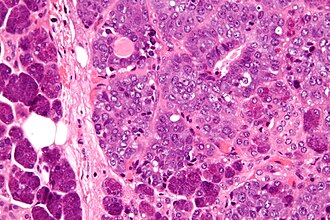Difference between revisions of "Epithelial-myoepithelial carcinoma"
Jump to navigation
Jump to search
(→General: weak) |
|||
| Line 35: | Line 35: | ||
*Usually older people - 50s or 60s. | *Usually older people - 50s or 60s. | ||
*Usually parotid gland ~ 60% of cases.<ref name=pmid17197918/> | *Usually parotid gland ~ 60% of cases.<ref name=pmid17197918/> | ||
*Prognosis: usually good; 5-year and 10-year survival over 90% and 80% respectively.<ref name=pmid17197918/> | *Prognosis: usually good; 5-year and 10-year survival over 90% and 80% respectively.<ref name=pmid17197918/> | ||
| Line 41: | Line 40: | ||
*Most common malignant component in ''[[carcinoma ex pleomorphic adenoma]]''. | *Most common malignant component in ''[[carcinoma ex pleomorphic adenoma]]''. | ||
*May be the same tumour as ''[[adenomyoepithelioma]] of the breast''.<ref name=pmid9769134>{{Cite journal | last1 = Seifert | first1 = G. | title = Are adenomyoepithelioma of the breast and epithelial-myoepithelial carcinoma of the salivary glands identical tumours? | journal = Virchows Arch | volume = 433 | issue = 3 | pages = 285-8 | month = Sep | year = 1998 | doi = | PMID = 9769134 }}</ref> | *May be the same tumour as ''[[adenomyoepithelioma]] of the breast''.<ref name=pmid9769134>{{Cite journal | last1 = Seifert | first1 = G. | title = Are adenomyoepithelioma of the breast and epithelial-myoepithelial carcinoma of the salivary glands identical tumours? | journal = Virchows Arch | volume = 433 | issue = 3 | pages = 285-8 | month = Sep | year = 1998 | doi = | PMID = 9769134 }}</ref> | ||
*An analogous [[lung tumour]] exists - see ''[[epithelial-myoepithelial carcinoma of lung]].<ref>{{Cite journal | last1 = Nakashima | first1 = Y. | last2 = Morita | first2 = R. | last3 = Ui | first3 = A. | last4 = Iihara | first4 = K. | last5 = Yazawa | first5 = T. | title = Epithelial-myoepithelial carcinoma of the lung: a case report. | journal = Surg Case Rep | volume = 4 | issue = 1 | pages = 74 | month = Jul | year = 2018 | doi = 10.1186/s40792-018-0482-8 | PMID = 29987577 }}</ref> | |||
==Microscopic== | ==Microscopic== | ||
Revision as of 00:20, 18 March 2019
| Epithelial-myoepithelial carcinoma | |
|---|---|
| Diagnosis in short | |
 Epithelial-myoepithelial carcinoma. H&E stain. | |
|
| |
| LM | biphasic tumour with (1) epithelial layer, and (2) myoepithelial layer; variable architecture (solid, cystic, tubular, papillary); +/- spindle cells |
| LM DDx | adenoid cystic carcinoma (tubular variant), pleomorphic adenoma, tubular variant. |
| IHC | CAM5.2 +ve (epithelial comp.), p63 +ve (myoepithelial comp.) |
| Site | salivary gland - usually parotid gland |
|
| |
| Signs | salivary gland mass |
| Prevalence | very rare |
| Clin. DDx | other salivary gland masses |
Epithelial-myoepithelial carcinoma, abbreviated EMCa, is a rare malignant salivary gland tumour.
General
- Rare ~1% of salivary gland tumours.[1]
- Female:male = 1.5:1.[2]
- Usually older people - 50s or 60s.
- Usually parotid gland ~ 60% of cases.[2]
- Prognosis: usually good; 5-year and 10-year survival over 90% and 80% respectively.[2]
Notes:
- Most common malignant component in carcinoma ex pleomorphic adenoma.
- May be the same tumour as adenomyoepithelioma of the breast.[3]
- An analogous lung tumour exists - see epithelial-myoepithelial carcinoma of lung.[4]
Microscopic
Features:
- Biphasic tumour:[2]
- Epithelial layer.
- Myoepithelial layer - key feature.
- Architecture: variable (solid, cystic, tubular, papillary).
- +/-Spindle cells.
- Basement membrane-like material; may mimic adenoid cystic carcinoma.
Notes:
- Usually few mitoses.
DDx:
- Adenoid cystic carcinoma (tubular variant).
- Pleomorphic adenoma, tubular variant.
- Has focal epithelial-myoepithelial carcinoma-like areas.
Images
www:
IHC
- CAM5.2 +ve -- epithelial component.
- p63 +ve -- myoepithelial component.
See also
References
- ↑ Tralongo, V.; Daniele, E.. "Epithelial-myoepithelial carcinoma of the salivary glands: a review of literature.". Anticancer Res 18 (1B): 603-8. PMID 9568184.
- ↑ 2.0 2.1 2.2 2.3 Seethala, RR.; Barnes, EL.; Hunt, JL. (Jan 2007). "Epithelial-myoepithelial carcinoma: a review of the clinicopathologic spectrum and immunophenotypic characteristics in 61 tumors of the salivary glands and upper aerodigestive tract.". Am J Surg Pathol 31 (1): 44-57. doi:10.1097/01.pas.0000213314.74423.d8. PMID 17197918.
- ↑ Seifert, G. (Sep 1998). "Are adenomyoepithelioma of the breast and epithelial-myoepithelial carcinoma of the salivary glands identical tumours?". Virchows Arch 433 (3): 285-8. PMID 9769134.
- ↑ Nakashima, Y.; Morita, R.; Ui, A.; Iihara, K.; Yazawa, T. (Jul 2018). "Epithelial-myoepithelial carcinoma of the lung: a case report.". Surg Case Rep 4 (1): 74. doi:10.1186/s40792-018-0482-8. PMID 29987577.
- ↑ [http://www.pathologyimagesinc.com/sgt-cytopath/epith-myoepith-ca/cytopathology/fs-emc-cytopath-feat.html "Cytopathologic Features of Epithelial-myoepithelial Carcinoma"]. http://www.pathologyimagesinc.com/sgt-cytopath/epith-myoepith-ca/cytopathology/fs-emc-cytopath-feat.html. Retrieved January 18, 2011.


